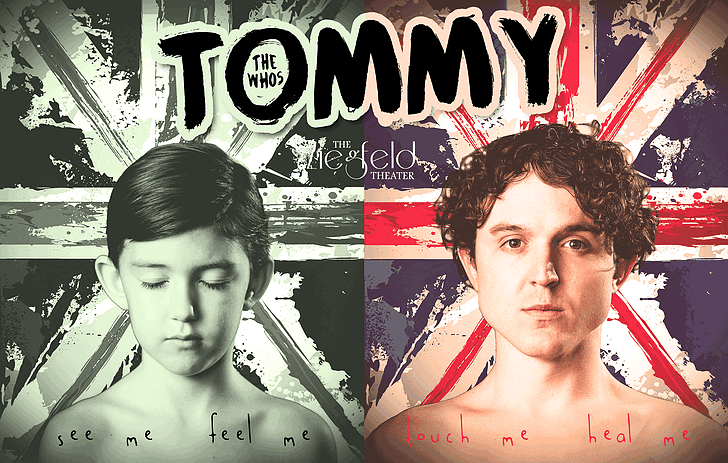OGDEN — The Ziegfeld Theatre in Ogden has taken on the rock opera The Who’s Tommy, based on the 1969 album of the same name with music and lyrics by Pete Townshend (with additional music and lyrics by John Entwistle and Keith Moon). Having heard some of the music but never seeing a production of this show, I was intrigued not only at seeing the story unfold onstage but discovering how director Caleb Parry would bring this type of show to life.

The story of The Who’s Tommy begins with Captain and Mrs. Walker (played by Cameron Kapetanove and Heidi Potter Hunt, respectively), who fall in love and get married just before World War II. Captain Walker goes off to war and becomes lost as a prisoner, while Mrs. Walker and her son—Tommy—that the Captain never met, move on with their lives. Tragedy strikes when Captain Walker comes home, and Tommy (played at two different ages by Grace Hunt and Annie Hunt, and as an adult by Jeremy R. Gross) witnesses an event that sends him into a traumatic state where he becomes unresponsive to everything around him. Throughout his childhood, the audience sees Tommy used and abused by extended family members and sent to every doctor (or quack) that might be able to cure him. The events both in his mind and in the real world participate in the chronology, and leave the audience pondering the things they do and the people they hurt.
The set was just plain black and white, with three panels of white screens, and white doorway pillars. While the initial impression was the interesting plainness of Caleb Parry’s set design, from the opening orchestration and number it was clear that this decision was made to magnify the elements of lighting design by Eliza Haymie and the astonishing and integral design of screen projections used on the three screens with great decision and detail throughout the entire production. A class at Weber State University, Studio 76, created the projections, and their work resulted in bringing an amazing dynamic to the show, with distorted pictures indicative of the challenges going on in the mind of the main character, to the chaos and confusion of the events that took place. This technical choice, along with the lighting by Haymie, allowed the audience to be transformed into the world on stage in amazing fashion.
One of the best elements of the show was the music by the live band with Sharon Datuin as conductor and on keyboards, Jacob Lambros on guitar, Daniel Tracy on bass, and Christopher Stilling on percussion. Thanks to the band, this production focused on the “rock” part of the show’s rock opera roots to great effect. Sadly, some of the microphones at the Ziegfeld had troubles and made it difficult to hear some of the players, but rather than have the band back down, I would like to see the microphone issues resolved.
All of the actors were well cast and built a thought-provoking show. The ensemble excelled at harmonization, and music director Kyle Lawrence brought the cast together in difficult musical numbers to provide a beautiful sound. While the show itself does not have much humor, actors like Timothy Behunin (fabulously playing Uncle Ernie) were able to take even small stage mishaps and utilize improvisation to keep the show on task in an amusing fashion. Behunin also had the difficult task of playing a rather unforgivable character in an empathetic way. Heidi Potter Hunt played Mrs. Walker as a loving, cool, and calm mother, which made her emotions in the song “Smash the Mirror” a highlight of the show. Her performance had a dramatic tension and frustration overflowing in a way that I know I have felt during the most difficult challenges of my life. Additionally, the lighting choice as she sang about anger rising was one of the best things I have seen on stage.
Gross had a difficult task before him when signing on for the role of Tommy. The role is physically and emotionally exhausting, while also being vocally challenging. Gross rose to the occasion with great flair, and his vocals were a strong match for the rock opera feel, while his facial expressions and physical movements painted an intense picture of the challenges faced by Tommy. Additionally, the young Hunt siblings playing young Tommy excelled at portraying a person unresponsive and lost in their own mind.
The Who’s Tommy is a very deep play. The cast at the Ziegfeld has put on an outstanding production, but my mind is still processing all the messages and I am still working on understanding all that was seen. It dealt with very heavy subject matter, from murder, sexual abuse, drug use, and mental illness. Those sensitive to these subjects should be aware before attending. However, this is the first time I have had the opportunity to see this show produced in Utah, and commend the theatre company for branching out and bringing important, if controversial, topics to the stage.
[box]The Who’s Tommy plays Fridays and Saturdays at 7:30 PM at The Ziegfeld Theater (3934 South Washington Boulevard, Ogden) through June 30, and at 2 PM on June 23. Ticket are $17-19. For more information, visit www.theziegfeldtheater.com.[/box]
Donate to Utah Theatre Bloggers Association today and help support theatre criticism in Utah. Our staff work hard to be an independent voice in our arts community. Currently, our goal is to pay our reviewers and editors. UTBA is a non-profit organization, and your donation is fully tax deductible.
